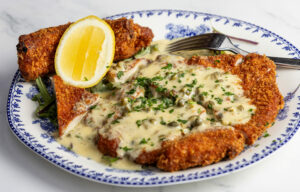 It happened before we were ready, which is often the way with death.
It happened before we were ready, which is often the way with death.
Walking toward the barn, a 22-caliber rifle popped once. Then again.
Despite being barely 8 a.m. in the morning, Chef John Stewart and I rush toward a small pig sty in the freezing hills north of Santa Rosa. “Damn. We missed it,” I said, having spent the previous 24-hours emotionally girding myself to watch a 300-pound animal die at my feet. The pigs had been shot. The slaughter doesn’t wait.
Stewart purchased one of the Duroc sows last July, banking on juicy hams come winter. For the last five years he’s been curing pork for Black Pig Meats as a side project to his two restaurants. When I first heard about it, he was doing most of the aging in his garage for friends and family. Now he graces the celeb-salumi circuit and cover of Wine Spectator.
Great prosciutto, pancetta and ham, however, all start with a pig whose fate is sealed the day it’s born. A very real part of being a meat-monger is overseeing their demise, and on this cold January morning Stewart’s Slow Food philosophy extends to watching Sonoma County’s last remaining mobile slaughterer kill, skin and gut his pig.
 Entering the sty, the pigs already lay dead. Still twitching, blood gushes from a deep slash in each of their necks. Steaming. The heart continues to pump the blood out of the body in amazing quantities. The lone executioner, John Taylor of JT’s Custom Slaughter, claims that the single shot to the head immediately kills the animals.
Entering the sty, the pigs already lay dead. Still twitching, blood gushes from a deep slash in each of their necks. Steaming. The heart continues to pump the blood out of the body in amazing quantities. The lone executioner, John Taylor of JT’s Custom Slaughter, claims that the single shot to the head immediately kills the animals.
Still, it feels intrusive to watch the death throes of these 8-month old creatures. Taylor impassively wades through the muck, straw and blood, impaling the now-still animals under the jaw with a steel hook and dragging them to a small bulldozer.

The bodies jiggle and fluids leak out of every orifice. It’s graphic. Unconditioned to knowing meat any way other than in a neatly wrapped package it’s easy to ignore the reality of death. But, I’m here because I eat pork and it seems only fair to acknowledge how it gets to my table. I want to know.
I can’t help personalizing it, though. Rolling around in bed the night before, I wondered if they somehow knew today was their last day. I have to ask if they had names.
“Pork and chop,” Taylor deadpans. After years of killing and gutting livestock the act of death is unemotional, quick and skillful.
Did they have a good life, I wonder. “Never a day of stress. Until today,” the owner tells us.
“Not even today,” said Taylor, slicing off the pigs’ forelegs, using them as blocks to keep them from rolling over. Because he is here, there is no transporting or stressing the animals which otherwise would have had to travel three hours north to a slaughterhouse in Orland.
Taylor spends his days driving around the North Bay in his custom-built truck which includes a “gut bucket”, winch and hanging rack for the carcasses. There used to be others, but Taylor claims he’s the last in the county who’ll come to your farm and do your dirty work. “This is a dying art.”
 Despite a renewed interest in humane treatment of animals and small farm operations there isn’t enough money in on-site butchering to attract many takers. Plus it’s a damn lot of heavy, unpleasant work. “I’m getting to old for this,” Taylor tells us, leaning over the hosed-down animals, slicing through skin and bone. Well-honed knives make it look as effortless as slicing butter.
Despite a renewed interest in humane treatment of animals and small farm operations there isn’t enough money in on-site butchering to attract many takers. Plus it’s a damn lot of heavy, unpleasant work. “I’m getting to old for this,” Taylor tells us, leaning over the hosed-down animals, slicing through skin and bone. Well-honed knives make it look as effortless as slicing butter.
He’s becoming a meat-lebrity lately, after a few magazine articles about his work as a mobile slaughterer. “It’s a novelty, now.” Taylor never stops moving, slicing, cutting, finally hacking the animal in half. In a little over an hour, the two pigs are simply two carcasses ready for processing in the back of his truck. Taylor heads out to the next kill. It’s over.
Wiping the blood off my shoes, Stewart and I walk toward our vehicles. He loads two garbage bags filled with hearts, livers and heads into his truck for pate, heart sandwiches (a favorite of his wife) and pork jowls. But its the short, stubby legs he’s most excited about getting his hands on next week, after they’ve been processed.
“Those are going to be some nice hams,” he says dreamily. I can’t help but think he’s right.

Witness to the slaughter
It happened before we were ready, which is often the way with death.
Walking toward the barn, a 22-caliber rifle popped once. Then again. The sound, unmistakable.
Despite being barely 8 a.m. in the morning, Chef John Stewart and I rush toward a small pig sty in the freezing hills north of Santa Rosa. "Damn. We missed it," I said, having spent the previous 24-hours emotionally girding myself to watch a 300-pound animal die at my feet. The pigs had been shot. The slaughter doesn't wait.









